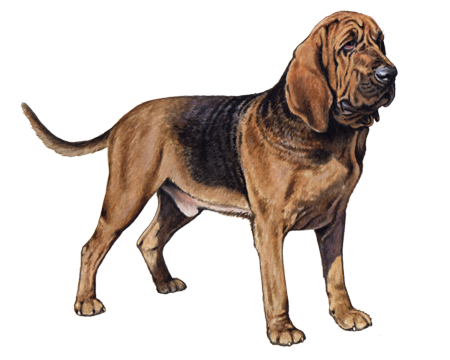
Catahoula Leopard Dog
The Catahoula Leopard Dog may be a beautiful breed, but there’s a lot to consider before taking one of these working dogs home. They can be territorial and protective, so early training and socialization is necessary. If properly trained, you’re left with a dog that is loyal and affectionate. There are few Catahoula Leopard Dogs these days, and as such they are members of the American Kennel Club’s Foundation Stock Service, which aims to help purebreds continue to develop while maintaining reliable records.
Interested in discovering if your dog is a Catahoula Leopard Dog?
Check out Wisdom Panel's DNA tests.

Catahoula Leopard Dog Traits
General Appearance
The Catahoula Leopard Dog is a medium-sized, athletic dog that’s most often associated with the mottled coat that is so common in the breed, but they can actually come in many different colors and patterns. The Catahoula eye can also be different colors or combinations.
Coat and Colouring
The Catahoula Leopard Dog is named so in reference to the mottled coat of most Catahoulas, which resembles a leopard, and is the result of the merle gene. However, not all Catahoulas have a mottled coat, and the breed actually comes in a variety of coat colors and patterns.
Distinctive Physical Traits
The two most distinctive physical traits for the Catahoula Leopard Dog are both its coat and its eyes. The coat is most often mottled (hence the name “Leopard”), while their eyes can come in a variety of colors as well, and each one can be a different color.
Catahoula Leopard Dog Temperament
This breed has a strong work ethic, and requires plenty of exercise to get out all of their pent up energy. Although they can be reserved and territorial with strangers, with the proper training and socializing, they become loyal and loving pets.
Once Catahoula Leopard Dogs understands their place within the family ranking, they are affectionate and loyal. Since they are traditionally pack hounds, they do best with owners who are dominant and can lead.
Early training and socialization is essential for this breed, especially since they can be territorial and reserved with strangers. Without the proper training and exercise they can also become destructive.


Catahoula Leopard Dog History
The Catahoula Leopard Dog is the result of years of mixed breeding. The original dog—referred to as “the Native American’s dog”—was already present when Spanish explorer Hernando de Soto landed in Florida in 1539 and took note of them. These dogs—which were said to look like wolves but bark like dogs—were crossed with many different breeds, including Greyhounds, Bloodhounds and Mastiffs. In Louisiana—where the dog is still revered—Native Americans started calling these dogs “Wolf Dogs.”
After being crossed again with French hounds, the resulting dogs became what we refer to today as Catahoula Leopard Dogs. In the Catahoula Lake area of Central Louisiana, the breed was used to corral wild hogs and cows. Over time they perfected their efforts, creating a “fence” around the herd and directing them to where they needed to go.
Catahoula Leopard Dog Care
Nutrition
Catahoula Leopard Dogs require a high-quality dog food that is age-appropriate—whether it’s commercially manufactured or homemade (with a veterinarian’s supervision and approval). It’s important to monitor the amount of food you give your Catahoula Leopard Dog. Reduce the portions or restrict calories if your pup gains weight. Your veterinarian is always a good source to help provide you with appropriate nutrition and feeding guidelines.
Grooming
Like most dogs, the Catahoula Leopard Dog has a coat that requires regular grooming. Weekly brushes, along with occasional baths, will keep it in top shape.
All dogs require regular dental care, including at-home teeth brushing and professional dental cleanings, and the Catahoula Leopard Dog is no exception. Maintaining good dental hygiene is important for their overall long-term health.
Exercise
As they are very active and don’t do well in pent-up areas or small homes, you should provide ample exercise for your Catahoula Leopard Dog, Without plenty of movement and stimulation each day, these dogs can become destructive with undesirable digging and chewing.
Luckily, the Catahoula Leopard Dog loves almost any activity. It adores swimming, hiking, or other outdoor retrieving activities, like fetch or Frisbee. Walks work as well, especially if you take multiple walks a day. This breed also enjoys dog sports, like agility, which are a great way to provide them with the exercise they need and crave.
Training
Since the Catahoula Leopard Dog has an independent and destructive streak, early and proper training is important. They can also be shy around strangers and territorial, so socialization is essential. Once they’ve been properly trained, though, the Catahoula Leopard Dog is loyal and gentle.

Catahoula Leopard Dog Genetic Health Conditions
-
Chondrodystrophy (CDDY) and Intervertebral Disc Disease (IVDD) Risk
Chondrodystrophy (CDDY) is a skeletal disorder characterized by shortened limbs and abnormal early degeneration of the spinal discs, or intervertebral disc disease (IVDD), which predisposes to disc herniation.
-
Hyperuricosuria
Hyperuricosuria (HUU) is a condition that predisposes affected dogs to the formation of urinary stones, such as kidney or bladder stones.
Knowing if your Catahoula Leopard Dog is a carrier or at-risk for these conditions can help you and your veterinarian plan for your pup's lifelong care. With Wisdom Panel™ Premium, you can get results for over 200 genetic health tests.
Breed Group
Hound
The most common ancestral trait of this group is being used for hunting. Some use acute powers of scent to follow a trail while others demonstrate the gift of stamina as they run down a quarry. Beyond these two common traits, however, generalizations about hounds are hard to come by as the group is comprised of a very diverse lot of breeds.


































